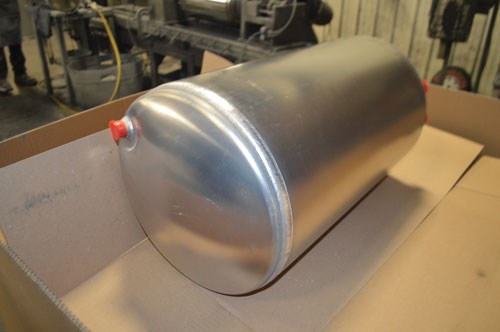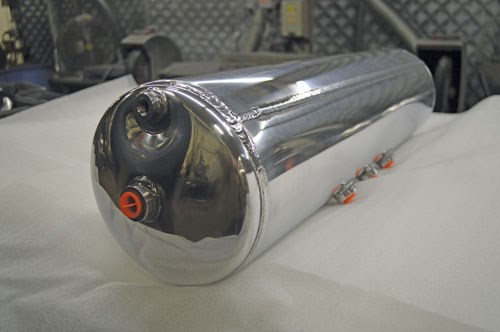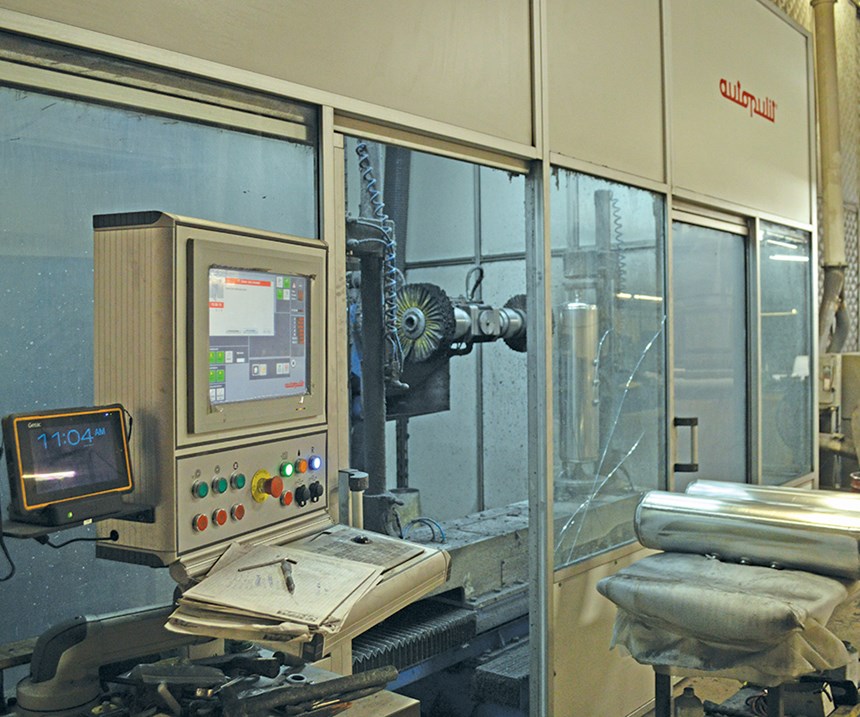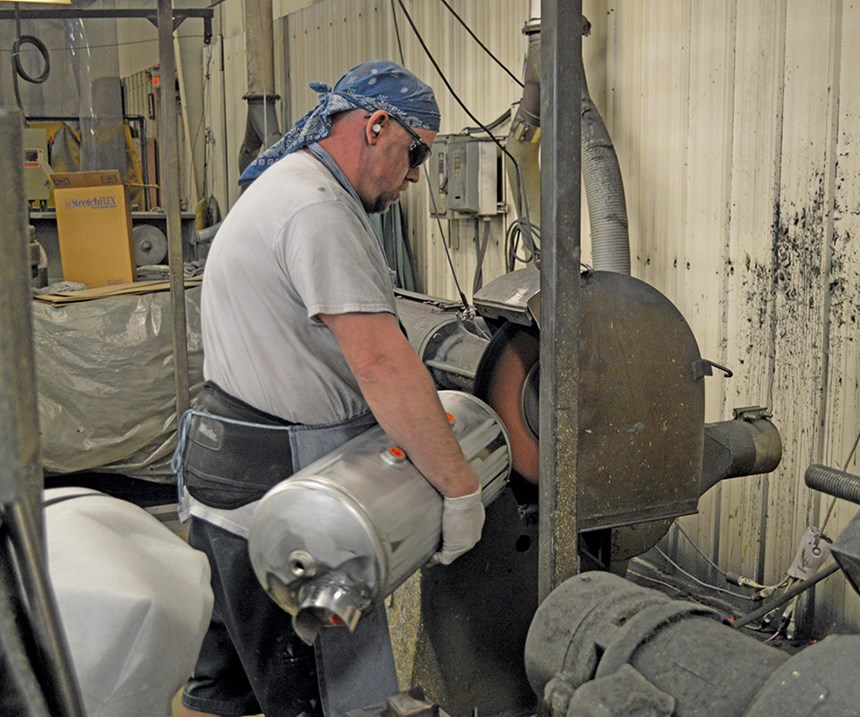Polishing Demands Lead to Innovative Solution
In the world that is Kinninger Production Welding in New Bremen, Ohio, polishing is not the biggest operation that owner Kevin Thobe’s team has to contend with—but it had certainly become one of the most demanding.
In the world that is Kinninger Production Welding in New Bremen, Ohio, polishing is not the biggest operation that owner Kevin Thobe’s team has to contend with—but it had certainly become one of the most demanding.
Kinninger is a full-service metal fabrication company that provides its customers with parts from simple laser-cut parts to large structural weldments. But when it came to grinding and polishing welds in various parts it was making for customers, the task became a little more arduous as the Kinninger craftsmen worked hard to provide the best finish to their clientele.
That was especially true on tanks for air brakes on tractor trailers that the company was manufacturing for a customer. Welds on both ends—with an additional 15-pipe fitting inlets protruding from the tank—made it difficult for workers to get the tanks ready for coatings as they grinded and polished the seams and welds.
“It would take our people anywhere from 15 to 20 minutes to grind the welds by hand to get each tank ready,” says Thobe. “It was a chore.”
As business picked up, Thobe knew he had to come up with a more efficient way to get the tanks grinded, polished and ready for coatings. The 20-minute timeframe would not work with the volume they needed to produce.
Speeding Up Production
Ryan Heckman, who is in charge of sales at Kinninger, says his company’s job was to put a satin finish on the tanks before they were installed on the tractor rigs. The company began to look for more automated ways to speed up production because of the long time it was taking to finish the tanks.
“We just kept seeing more and more time that was being needed to get these tanks grinded and polished,” Heckman says.
In 2008, the facility installed a working cell to automate the grinding process. Thobe’s father, Jack, purchased the equipment and got it up and running to speed production.
Kinninger began in 1966 as a weld shop with Crown Lift Trucks as its only customer. The company progressed to a full-service metal fabrication company, with customers in the medical, agriculture, specialty vehicle, material handling and food industries.
Jack, and his wife Donna Thobe, purchased the company in 1993 with seven other employees and a goal to grow the successful family-owned business. Two years later, Kinninger moved from a 4,000-square-foot facility to its current location, which at the time had only 16,000 square feet.
Expansion of the company and plant soon took off, necessitating the addition of more than 20,000 square feet in 2002 to house new equipment, including two lasers, a turret press and in-house powder coating.
In 2008, Kinninger again expanded with an additional 18,000 square feet, and built on 20,000 more square feet four years later to make room for a Salvagnini laser with automatic load and unload, bringing the plant to its current 74,000 square feet with 50 employees working two shifts.
Jack and Donna then sold the company to Thobe, and his wife, Cheryl. In 2014, Kinninger worked its way to becoming a “one-stop shop” with the addition of CNC machining capabilities.
Faster Grinding Needed
But it was the grinding and polishing equipment that was demanding most of Thobe’s attention, and with the decline in the cost of diesel fuel over the past few years, the demand for tractor trailers rose significantly, and so did the company’s workload.
“We were getting slammed,” Thobe says. “It seemed like everybody was buying semis, and we just couldn’t keep up with the work.”
Like his father before him, Thobe went back to the drawing board to find a faster way to grind and polish the tanks. His search led him to Skip Doyle, a representative at Fast Machine Tool in Cincinnati.
Owners Doyle and Don Hoffman supply manufacturers with equipment that removes the mundane or slow functions of production and increases throughput and efficiencies. Doyle suggested to Kinninger that they work with AM Machinery Sales, Inc. in Warminster, Pennsylvania, which provides manufacturers with solutions for deburring, belt grinding, polishing, buffing and micro-finishing.
Automated Machinery
AM Machinery’s Tony McCue knew right away that Kinninger would benefit from an Autopulit surface grinding machine for the grinding, satin finishing, deburring and polishing of a large variety of parts using an automated finishing process with multiple grinding and polishing operations.
McCue says the Autopulit machine is a numerically controlled CNC machine that provides many options for the user because its capacity, flexibility and technology make it possible to finish, brush and polish a variety of pieces that once required special solutions.
The Autopulit CNC HD is developed with a specific software for abrasive belt grinding and polishing that is easy to program by means of a menu-driven interactive system, which McCue says does not require any programming or computer science knowledge.
The machine incorporates automatic buff-wear compensation—axes X,Y and Z simultaneously—verifying the movements, self-diagnosis and teleservice through the internet, and through the integration in the computer network of the end-user.
“I have about 20 of these installed in the U.S. market, and they worked wonders in speeding up the process and doing a fantastic job in grinding and polishing,” McCue says. “We put the HD2 model machines in for Kinninger, and it has a capacity of 40 inches, so it is a little bit smaller than the HD1 model, which you could put the front end of a truck on it and have it polished.”
Flexible Design
McCue and Doyle visited Kinninger’s plant and worked with Thobe and his team to fine-tune the specifications before heading off to Spain a few months later and inspecting the machine being built in the Autopulit manufacturing plant. After the four months it took to build the HD2, Thobe went to Spain to see the machine in operation.
“The machine was designed for the air tanks, but it can be used for just about anything,” McCue says. “It’s extremely versatile and flexible. Whatever parts need to be polished in the future, this machine can be programmed to do it.”
With a 40-inch opening, McCue says the HD2 is the perfect fit for shops that need a quick turnaround of a batch of parts.
“It’s great if a shop needs 20 of these, or 50 of those,” he says. “It can do high production, but it is really designed for job shop production needs. The parts can be moved around quickly and easily.”
The majority of tanks that the company needed to finish were about 36 inches long, which enabled them to easily fit inside the 40-inch work cube of the Autopulit HD2. But they did get some tanks that were over the 40-inch limit, which required the machine to be raised about 12 inches to accommodate the bigger size.
“We have it now so that it would accommodate every tank size that Kinninger has,” McCue says. “It’s just a matter of extending the height of the machine, and that really isn’t a difficult process.”
Quick Turnaround
Kinninger needed to shorten the time that was spent on each tank, so there needs to be improvement from the 15- to 20-minute range per tank to get the required finish.
Thobe says they wanted to get the tanks completed in the 5- to 12-minute range each, a goal that was accomplished fairly quickly. Disparity in time is caused by dents or scratches that may be on the tanks when they arrive at the Kinninger plant.
“Sometimes they come in all scratched up and dented, and then it does take the longer time,” Thobe says. “But we like to get them done in just over 5 minutes, which is optimal.”
Thobe originally estimated the payback at two years from his investment, but a recent slowdown in the production of tractor trailers has also slowed his payback time.
In addition to the throughput improvements, Thobe says there has been a huge improvement in consistency and quality compared to grinding and polishing by hand.
“Every tank going out that door looks exactly the same,” he says.
Heckman says having the Autopulit machine on the shop floor is a great selling tool when Kinninger talks to potential customers about taking on their work.
“Polishing can be such an evil thing some times,” Heckman says. “One person can look at a part and find it acceptable, and another can look at the same part and see flaws. I think with this equipment, we are better at managing
their expectations.”
Some of Kinninger’s employees were a little hesitant in accepting an automated process that might replace them in long run, but Thobe says that once they saw the Autopulit HD2 in action, they were
all impressed.
“A few of them actually said to me, ‘This thing will save my back,’” he says. “Now, they have all come around.”
For information, visit kinningerwelding.com, ammachinerysales.com and fastmachinetools.com.
Originally published in the July 2016 issue.
Related Content
Lapping, Polishing Film Maximizes Strengths, Maintains Flexibility
Dia-Strip and Dia-Sheet film from Titan Tool Supply has a distinct construction that the company says makes it durable while remaining flexible, bendable and formable.
Read MoreUnderstanding Shot Peening
A look inside shot peening — a process of “hammering” of work pieces with precisely defined blast media.
Read MoreBlast Nozzle Features Enhanced Noise Reduction
Kennametal adds noise-reducing Blast Ninja to portfolio of abrasive blast nozzles.
Read MoreHubbard-Hall Technical Team Adds Senior Chemist to Staff
David Keller is joining the Hubbard-Hall technical team as a senior chemist.
Read MoreRead Next
Raising the Bar on Polishing
Glastender builds bar equipment faster thanks to AM Machinery, Autopulit.
Read MoreEducation Bringing Cleaning to Machining
Debuting new speakers and cleaning technology content during this half-day workshop co-located with IMTS 2024.
Read MoreEpisode 45: An Interview with Chandler Mancuso, MacDermid Envio Solutions
Chandler Mancuso, technical director with MacDermid Envio discusses updating your wastewater treatment system and implementing materials recycling solutions to increase efficiencies, control costs and reduce environmental impact.
Read More














.jpg;maxWidth=300;quality=90)











